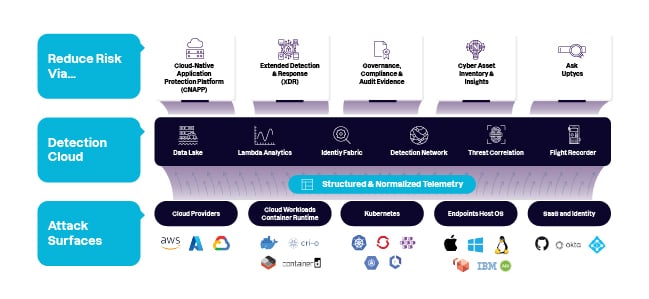Organizations worldwide are harnessing the power of cutting-edge technologies and methods, such as cloud-native development, to implement their digital transformation strategy. However, the journey toward digital transformation is not without its challenges, particularly when it comes to securing new digital environments.
Your digital transformation strategy must include security
Faced with the relentless onslaught of cutting-edge cyber threats, the age-old armor of perimeter-based security is beginning to show some cracks. The world of multi-cloud landscapes and intricate application infrastructures demands a more fortified defense. Yet, in the fast-paced realm of cloud-native evolution, security teams can find themselves racing against the unknown, a race where falling behind could mean exposing the core of the organization to vulnerabilities. It's time to rewrite the rules of protection.
Uptycs saw that current conditions demanded a unified security solution, which is why we introduced the world’s first unified cloud-native application protection platform (CNAPP) and XDR (Extended Detection and Response) solution.
In a recent Enterprise Strategy Group (ESG) white paper, "Securing the Expanding Cloud-native Attack Surface with Unified XDR and Cloud-native Application Protection," you’ll discover how Uptycs' unified data model plays a pivotal role in enhancing a robust digital transformation strategy.
The role of cloud-native development
Digital transformation is being propelled forward by cloud-native development, which leverages cloud technologies for speed, flexibility, and agility in creating applications. This paradigm allows developers to provision their own infrastructure swiftly, thanks to Infrastructure as a Service (IaaS) and Platform as a Service (PaaS) offerings. This acceleration eliminates bottlenecks typically associated with traditional infrastructure provisioning and fosters a culture of rapid innovation.
In cloud-native development, APIs and other services enable dynamic infrastructure management, promoting efficiency and rapid delivery. The transition to this model is not just a technological shift; it's a fundamental change in organizational operation, aligning with the dynamic pace of the digital era. However, this new approach necessitates innovative security solutions, such as the unified CNAPP and XDR approach to address emerging challenges.
Navigating the security challenges of cloud-native development
Cloud-native development, while a cornerstone of an effective digital transformation strategy, introduces unique security concerns. As organizations make the leap into the cloud, they're often confronted with the realities of an expanded and dynamic attack surface, necessitating a fresh approach to security.
Here are a few key security issues that organizations should prioritize:
- Software supply chain security: As developers frequently leverage third-party code, resources, and APIs, they inadvertently create an interconnected web of dependencies. This complex web, if compromised, can have significant repercussions on the entire software supply chain. As such, securing the software supply chain is a critical concern for organizations deploying cloud-native applications.
- Attack surface visibility: The expansion and dynamism of the attack surface in the cloud-native landscape make it difficult for security teams to maintain a comprehensive view of their digital environment. With the growing complexity of digital ecosystems, the need for improved tools and methodologies to enhance attack surface visibility has never been more paramount.
- Security integration throughout SDLC: Traditionally, security measures were often an afterthought in the software development life cycle (SDLC). However, with cloud-native development, integrating security processes and tools throughout the SDLC has become a necessity. The challenge lies in incorporating these security solutions without disrupting the speed and efficiency of cloud-native development.
Addressing these challenges calls for an innovative solution that caters to the dynamic nature of cloud-native development and ensures robust protection of digital assets. This is where the concept of a unified CNAPP and XDR security solution comes into play.
Infusing security throughout development
Recognizing these challenges, it's clear that security can no longer be an afterthought in the development process. Instead, security processes and tools must be integrated throughout the Software Development Life Cycle (SDLC).
Traditional security solutions, which were designed for monolithic architectures, often struggle to adapt to the fluidity and complexity of cloud-native environments. These tools can be disruptive to the fast-paced nature of cloud-native development, leading to bottlenecks and delays.
Moreover, siloed security tools often lack the capacity to effectively manage the sheer scale and dynamism of modern, cloud-based environments. They require more time to operate, manage, and analyze results, delaying critical remediation actions.
As a consequence, there is a growing demand for security solutions that can blend seamlessly with cloud-native development processes. Such solutions need to drive remediation efficiency, allowing for the quick identification and resolution of security issues. They should also enable better coordination of security processes across the SDLC to ensure that all development activities, from inception to deployment, are performed with a security-focused mindset.
Unified CNAPP and XDR: An effective solution for cloud-native security
The ESG white paper, "Securing the Expanding Cloud-native Attack Surface with Unified XDR and Cloud-native Application Protection," brings to light how unified CNAPP and XDR, when implemented correctly, can effectively enhance security, improve threat detection, and expedite response times.
 Uptycs unified CNAPP and XDR solution at a glance
Uptycs unified CNAPP and XDR solution at a glance
At the heart of the unified CNAPP and XDR solution is the unified data model, a powerful mechanism that consolidates and analyzes security data from across the organization's digital environment. This comprehensive data view can provide security teams with critical insights to proactively identify and mitigate potential security risks.
If you're keen on exploring the intricacies and broader implications of CNAPP, check out our comprehensive piece on “What is CNAPP? What it Means and Why It Matters.”
Uptycs, a leader in cloud-native security, offers an innovative unified data model. This approach enables organizations to secure their cloud-native development activities effectively and efficiently, even as these activities continue to expand in scale. Uptycs does this by combining telemetry data from disparate sources, unifying it into a single coherent data model that can be queried and analyzed for security insights. This gives organizations the visibility and control they need to secure their evolving attack surface.
Shifting up your digital transformation
Digital transformation, fueled by cloud-native development, has numerous advantages for organizations in terms of speed, flexibility, and efficiency. However, these advantages don't come without their share of security challenges.
The solution lies in a unified approach to security, combining CNAPP and XDR. This approach, as outlined in the recent ESG whitepaper, offers an innovative solution that addresses the unique security needs of the cloud-native development environment.
Cloud-native development, with all its advantages and challenges, is the future of digital transformation. Embracing this future means adapting our development practices and our approach to security. With Uptcys, you can confidently navigate this journey, ensuring that security is not an afterthought but a key driver of successful digital transformation.
Shift up your digital transformation strategy with Uptycs – Learn how:








